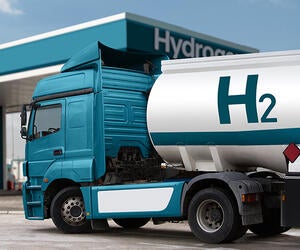How MEA design can make fuel cells a viable option for heavy-duty vehicles

Industry Articles, United States
In this Q&A article, Shinichi Nishimura, a global product specialist for fuel cell technologies at Gore, discusses the potential of fuel cells in decarbonizing the transportation industry. With a keen focus on the pivotal role played by the membrane electrode assembly (MEA), Shinichi provides valuable insights and expertise on this critical component.
Recent advancements in proton exchange membrane (PEM) technology have made hydrogen fuel cells a viable alternative to diesel engines for heavy-duty vehicles (HDVs). PEM fuel cells offer scalability, durability, and power density, making them suitable for long-haul commercial transportation. However, there are challenges to overcome, including high initial vehicle costs and material durability limitations.
Shinichi stressed that a critical component of fuel cell stacks, the MEA, faces challenges in HDV applications. The MEA is subject to physical and chemical damage during operation, leading to performance degradation and early failure. Overcoming these challenges requires a focus on MEA design and durability. The transition region of the MEA, which is exposed to physical damage and chemical contamination, plays a crucial role in power density, energy efficiency, and structural integrity. A prudent design with robust materials is essential for producing reliable MEA that can withstand tough operating conditions.
GORE-SELECT® Membranes effectively reduce resistance or permeance without compromising other crucial qualities, enabling MEA manufacturers to overcome development trade-offs. Moreover, our membranes demonstrate outstanding resistance to hygro-thermal stress and chemical contamination, while also exhibiting lower gas permeation rates, effectively minimizing damage from gas crossover. When combined with Gore's extensive experience, materials science expertise, and commitment to continuous innovation, we deliver a reliable and high-quality solution that helps lower the total cost of ownership.
Uncover the full Q&A article with Shinichi to gain deeper insights into the sigificance of MEA design in making fuel cells a viable option for heavy-duty vehicles.
To get this article in a nice and easy to print or share format, please download the PDF by submitting the form below: